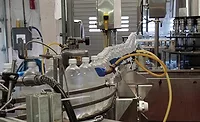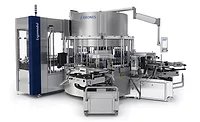Beverage fleets evolve to meet industry needs
Driver safety and comfort among top equipment demands
Fleet equipment and technology are evolving at an unprecedented pace, with vehicles approaching obsolescence after only a brief time on the road. The many demands of delivery operations can be distilled down to four overarching trends: the need to enhance driver safety, efforts to reduce driver fatigue by optimizing ergonomics and comfort, new product and order-building protocols that require dynamic trailer functionality and load configurations, and the ongoing challenge of reducing dependence on fossil fuels.
Safety technology
Collision-avoidance technology has developed to the point that few fleets can afford not to have some sort of crash-prevention or driver assistance-system installed on their vehicles.
“Equipment is changing much more dramatically these days, and most of it is really based around technology,” says Jim Lager, senior vice president of sales at Penske Truck Leasing. “Safety is a huge one with things like collision-mitigation systems. That’s really a no-brainer in my mind because one rear-end collision is going to cost the operator six figures — seven figures if there’s a fatality.”
Electronic stability control is another feature that’s gained widespread adoption, especially as the technology improves.
“A lot of these technologies are kind of starting out in automotive and then finding their way into the Class 8 vehicle market,” says Fred Andersky, director of customer solutions for controls and director of government and industry affairs for Bendix. “I think we’re going to see a continued move down through the classes, Class 7, Class 6 and even down through [Class] 5, 4 and 3 vehicles.”
Houston-based Silver Eagle Distributors has been rolling out the Lytx DriveCam dashboard cameras across its fleet and already has seen significant improvements in driver behavior.
“The technology records events or near misses and provides us the opportunity to see exactly what happened in the case of an accident,” says Ed Pritchard, Silver Eagle’s senior vice president of fleet management and purchasing. “With customized, programmable parameters for acceleration rates, lateral g-force, etc., immediate action can be taken to coach or correct drivers who’ve experienced near-misses due to bad habits like distracted driving.”
Pritchard expects to have Lytx monitoring Silver Eagle’s entire fleet by the end of 2018.
Driver comfort
Driver safety and comfort are not mutually exclusive, and many of the latest design developments have focused on enhancing the driver experience. A big part of that involves reducing fatigue.
For instance, more automatic transmissions are being implemented in commercial vehicle classes that had once been almost exclusively manual.
“Automatic transmissions are essentially starting to make it as easy as getting into your car, pushing a button and driving,” Lager says. “And that’s helping to open up the driver pool to people who weren’t previously able to drive a truck.”
Trailers and load configurations
Silver Eagle, like many of its distribution peers, has been purchasing more refrigerated trailers as of late, thanks to a steady increase in draft sales.
“A lot of that comes from the proliferation of craft brands all across our market areas,” Pritchard says.
And, as has been the trend for some time, Silver Eagle continues to deploy a growing number of rear-load/bulk trailers to enable it to fit more orders on the trucks and speed the delivery process at larger-volume accounts like supermarkets.
However, that doesn’t mean the side-load era is coming to a close.
“There is a slight resurgence in the need for smaller bobtail side-load trucks to deliver in densely populated urban areas where there are numerous on-premise accounts,” Pritchard explains.
Alternative fuel vehicles
Beverage fleets continue to explore and integrate alternative fuel vehicles into their operations, but activity around such equipment has slowed throughout the past few years.
Currently, fleet managers are waiting to see the impact of electrification in the medium- and heavy-duty truck segments, Pritchard notes. By late 2019 or early 2020, Tesla, Nikola, Motiv and Cummins Diesel all have been planning to roll out electric Class 8 trucks capable of carrying a gross weight of 80,000 pounds at a range between 200 and more than 400 miles on a single charge, according to Tesla.
“Tesla’s made a big splash with its Class 8 truck and has also made a lot of claims related to that,” Andersky says. “I think there’s a lot of interest there, but not just in electrification, but alternative energy sources for commercial vehicles in general — whatever helps reduce the dependence on fossil fuels.” BI
Looking for a reprint of this article?
From high-res PDFs to custom plaques, order your copy today!





